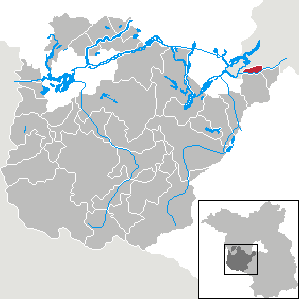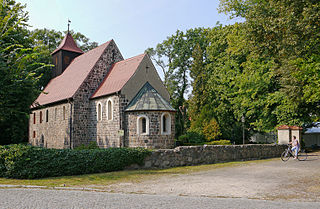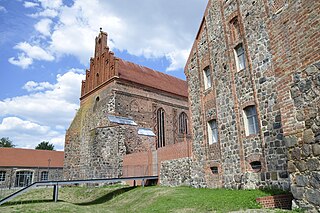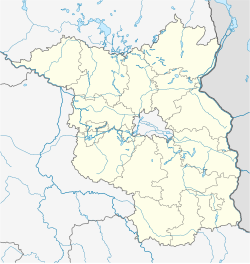
Havelland is a district or county in Brandenburg, Germany. It is bounded by the districts of Ostprignitz-Ruppin and Oberhavel, the city-state of Berlin, the district of Potsdam-Mittelmark, the city of Brandenburg and the state of Saxony-Anhalt.

Teltow-Fläming is a Kreis (district) in the southwestern part of Brandenburg, Germany. Neighboring districts are Dahme-Spreewald, Elbe-Elster, the districts Wittenberg in Saxony-Anhalt, the district Potsdam-Mittelmark, and the Bundesland Berlin.

Bad Belzig, until 2010 Belzig, is a historic town in Brandenburg, Germany located about 70 km (43 mi) southwest of Berlin. It is the capital of the Potsdam-Mittelmark district.

"Mein Herz brennt" is a song by German Neue Deutsche Härte band Rammstein. The song first appeared as the opening track to the band's third studio album, Mutter (2001), and was used as the opening track for concerts during that era. It also appeared on the band's greatest hits album Made in Germany 1995–2011 (2011), being the only song on the album that, at the time of release, had not been released as a single or had a music video. The song was released as a single in 2012 to promote the then-upcoming video collection Videos 1995–2012. A piano version of the song was released as a single on 7 December 2012.

Kloster Lehnin, or just Lehnin, is a municipality in the German state of Brandenburg. It lies about 24 km (15 mi) west-south-west of Potsdam.

Treuenbrietzen is a town in the Bundesland of Brandenburg, Germany.

Teltow [German pronunciation: ['tɛltoː](listen)] is a town in the Potsdam-Mittelmark district, in Brandenburg, Germany.

Kleinmachnow is a municipality of about 20,000 inhabitants in the Potsdam-Mittelmark district, in Brandenburg, Germany. It is situated South-West of the borough of Steglitz-Zehlendorf and east of Potsdam.

Stahnsdorf is a municipality in the Potsdam-Mittelmark district, in Brandenburg, Germany.

Wiesenburg is a municipality in the Potsdam-Mittelmark district, in Brandenburg, Germany. It is situated 10 km west of Bad Belzig, and 34 km southwest of Brandenburg. It is located in the High Fläming Nature Park.

Gräben is a municipality in the Potsdam-Mittelmark district, in Brandenburg, Germany.

Groß Kreutz is a municipality in the Potsdam-Mittelmark district, in Brandenburg, Germany.

Michendorf is a municipality in the Potsdam-Mittelmark district, in Brandenburg, Germany.

Nuthetal is a municipality in the Potsdam-Mittelmark district, in Brandenburg, Germany.

Schwielowsee is a municipality in the Potsdam-Mittelmark district, in Brandenburg, Germany. It is situated on the shore of the Schwielowsee lake, through which the River Havel flows. The municipality was founded on December 31, 2002 in merger of the three villages Caputh, Geltow and Ferch. The Caputh Ferry, a cable ferry across the Havel, links Caputh and Geltow. In the east Schwielowsee shares border with the City of Potsdam, in the west with the town of Werder (Havel).

Seddiner See is a municipality in the Potsdam-Mittelmark district, in Brandenburg, Germany.

Amt Ziesar is an Amt in the district of Potsdam-Mittelmark, in Brandenburg, Germany. Its seat is in Ziesar.

The Berlin/Brandenburg metropolitan region or capital region is one of eleven metropolitan regions of Germany, consisting of the entire territories of the state of Berlin and the surrounding state of Brandenburg. The region covers an area of 30,545 square kilometres (11,793 sq mi) with a total population of about 6.2 million.

Beelitz-Heilstätten station is a railway station in the district of Beelitz-Heilstätten which belongs to the town of Beelitz located in the district of Potsdam-Mittelmark, Brandenburg, Germany.



































